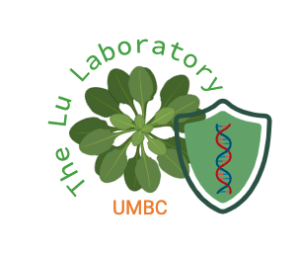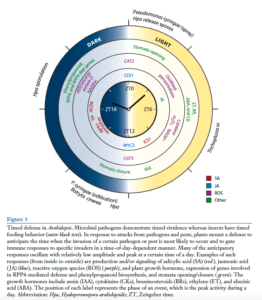 Plants are constantly challenged by pathogens and pests. Billions of dollars are lost each year due to plant diseases. Understanding how plants defend themselves against invaders will not only advance fundamental knowledge on host-pathogen interactions but also aiding in developing strategies to improve plant health and increase crop yield. The main research goal in the Lu laboratory is to use the model plant Arabidopsis thaliana to understand mechanisms of plant disease resistance. Currently we have two main research projects in the lab.
Plants are constantly challenged by pathogens and pests. Billions of dollars are lost each year due to plant diseases. Understanding how plants defend themselves against invaders will not only advance fundamental knowledge on host-pathogen interactions but also aiding in developing strategies to improve plant health and increase crop yield. The main research goal in the Lu laboratory is to use the model plant Arabidopsis thaliana to understand mechanisms of plant disease resistance. Currently we have two main research projects in the lab.
1. Elucidating salicylic acid signaling networks: The small phenoliccompound salicylic acid (SA) is critical for plant defense against a broad spectrum of pathogens, including viral, bacterial, and fungal pathogens. We have a powerful genetic tool, acd6-1 whose small size shows a a strong correlation with the severity of defense and death phenotypes. Thus acd6-1 can be conveniently used in throughput genetic screens toidentify genes with impaired defense in addition to study genetic interactions of defense mutants. We have identified many Arabidopsis mutants through acd6-1 suppressor (sup) screen. So far we isolated over 20 sup mutants, cloned five disrupted SUP genes, and have been in the process of study functions of the SUP genes. One of such SUP gene is FLK, an KH domain RNA binding protein. We recently received a NSF grant to study the molecular mechanisms underlying how FLK regulates defense and development.
screens toidentify genes with impaired defense in addition to study genetic interactions of defense mutants. We have identified many Arabidopsis mutants through acd6-1 suppressor (sup) screen. So far we isolated over 20 sup mutants, cloned five disrupted SUP genes, and have been in the process of study functions of the SUP genes. One of such SUP gene is FLK, an KH domain RNA binding protein. We recently received a NSF grant to study the molecular mechanisms underlying how FLK regulates defense and development.
2. Investigate molecular basis underlying the interplay between plant innate immunity and the circadian clock: The circadian clock is the internal time-measuring machinery critical for growth and development of many organisms and their responses to environmental stimuli. Although the molecular composition of the circadian clock differs greatly between plants and other organisms, the basic principle of clock function, which is the ability to self-sustain, is conserved. Recent work from several laboratories including my laboratory has established a direct role for the circadian clock in regulating plant defense against pathogen and pest challenges. In particular, my group was the first to show that defense activation by pathogen attacks could reciprocally affect clock activity, revealing the crosstalk between the circadian clock and plant innate immunity. The molecular basis underlying such crosstalk is unclear. A better understanding of this topic could provide much needed information on the temporal control of plant innate immunity.
clock: The circadian clock is the internal time-measuring machinery critical for growth and development of many organisms and their responses to environmental stimuli. Although the molecular composition of the circadian clock differs greatly between plants and other organisms, the basic principle of clock function, which is the ability to self-sustain, is conserved. Recent work from several laboratories including my laboratory has established a direct role for the circadian clock in regulating plant defense against pathogen and pest challenges. In particular, my group was the first to show that defense activation by pathogen attacks could reciprocally affect clock activity, revealing the crosstalk between the circadian clock and plant innate immunity. The molecular basis underlying such crosstalk is unclear. A better understanding of this topic could provide much needed information on the temporal control of plant innate immunity.